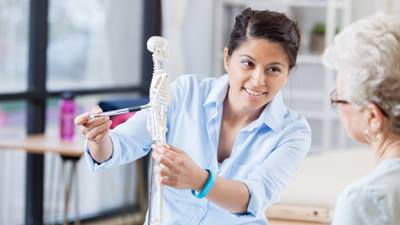Three Habits for Better Bone Health
Osteoporosis is a disease that causes the bones to lose density or thickness. Bones become fragile and can break easily, even when doing normal activities like stepping off a curb. Ten million Americans have osteoporosis and 80 percent of them are women. But osteoporosis doesn’t have to be a natural part of aging. Three critical habits can help your bones stay strong for a lifetime.
Most people don’t realize they have osteoporosis until they break a bone — usually after just a minor trauma. Osteoporosis is more commonly seen in adults aged 50 and older. In women, it is often seen about eight years after menopause, when a decrease in estrogen leads to bone loss. But your bones begin thinning years before that. That natural, irreversible process starts in your mid-20s. Other risk factors that can accelerate bone loss include:
- Gender—osteoporosis is more likely to occur in women than in men

- Age—although the disease accelerates at age 50, it can start at age 30 or younger
- Race—Caucasians and Asians are more likely to develop osteoporosis
- Body frame—someone with a petite frame is at greater risk, due to smaller, thinner bones
- Family history—your risk increases if a close family member also has the disease
- Previous fracture due to low level trauma—if you broke a bone in a minor incident, especially after the age of 50, you have a higher risk of osteoporosis
- Sex hormone deficiency—if you have low levels of a sex hormone, i.e. estrogen, it can increase your risk
- Eating disorders—especially anorexia nervosa can affect bone strength
- Cigarette and alcohol--use of these substances increases the risk of osteoporosis
- Low dietary intake of calcium and vitamin D--these are necessary for bone strength
- Medicines--certain medicines like steroids or those for the thyroid can affect bone strength
Symptoms of Osteoporosis
Even though a bone fracture is the most common first symptom, osteoporosis does have a few other subtle signs. If you’re over the age of 50 and start to lose height—over an inch—that could be due to breaks in the vertebrae in your spine.
These breaks may be painless, but eventually can cause curvature to your spine, resulting in a loss of height. In severe cases, broken bones in the spine can result in a dowager’s hump, or a condition known as kyphosis.
Treatment for Osteoporosis
Once osteoporosis has developed, the best option is to prevent further bone loss. In most cases, it is not possible to regain bone mass. Medication to maintain bone loss and lifestyle modifications are the usual course of treatment.
If you have severe osteoporosis, you will need to take great care to avoid falls and fractures. The likelihood of fractures can make it difficult to live independently. Severe spinal curvature can make it challenging to breath or complete daily living tasks or be socially active.
3 Habits to Combat Osteoporosis
Even though osteoporosis cannot be reversed, it can be prevented. Here are three ways to reduce the risk of developing osteoporosis:
Start preventive measures early. Don’t wait until you’re 50—or even in your mid-20s to preserve your bone health. Even in children, developing a 10 percent increase in peak bone mass reduces the risk of a fracture as an adult by 50 percent.
Have adequate intake of calcium and vitamin D. Calcium is a mineral that keeps bones and teeth healthy. We don’t produce it on our own, so it must come from foods we eat. Dairy foods like milk, yogurt and cheese, as well as dark, leafy vegetables are high in calcium. Vitamin D is necessary because it helps the body absorb calcium. Vitamin D is found in foods like fish, egg yolk and cheese, and in fortified milk, orange juice and ready-to-eat cereal. If you do not get enough calcium and vitamin D through your diet, you may want to include a multivitamin supplement.
Exercise daily. Physical activity, particularly weight-bearing exercise, puts stress on your bones in a good way, encouraging them to grow and become denser. Examples of weight-bearing exercises include walking, dancing, tennis and hiking. Check with your doctor before beginning an exercise program—especially if you have osteoporosis.
Osteoporosis may be difficult to detect initially. But why wait until it develops? Instead, follow these tips—starting today—to help your bones stay as strong as they can for a lifetime.
Choose to Stay in Touch
Sign up to receive the latest health news and trends, wellness & prevention tips, and much more from Orlando Health.
Sign Up for HealthBeat




